
The Weekly Fusion: A Look at Current Advancements in Fusion Energy
|11.01.15-11.16.15|
The future of fusion is constantly being unfolded in front of our eyes, as every week there is some breakthrough in new technologies and designs in the nuclear fusion sector of energy. Since there is such a wealth of information, I have gathered and consolidated a list of articles geared toward the advancement of making fusion energy a reality, from within the past week.
Weekly Fusion News
Bezos, Allen-fueled startups tackle nuclear fusion’s power
Dino Grandoni / The New York Times / 11.01.15
A way to harness the energy source, nuclear fusion — the reaction that gives birth to sunlight — still needs to be invented. Such an achievement has long evaded government scientists and university researchers, despite decades of work and billions of dollars in research. But backed by hundreds of millions in venture capital and some of the wealthiest people in the technology industry — including Amazon.com founder Jeff Bezos and Microsoft co-founder Paul Allen — a handful of young companies say they can succeed where government has fallen short.
Nuclear fusion just got a boost with the arrival of this stellarator
Michael Casey / Fox News / 11.02.15
Researchers could be one step closer to producing energy through nuclear fusion with word that a device called the stellarator is set to go online later this year in Germany.
Adam Cohen Becomes Deputy Under Secretary for Science and Energy in Washington
Princeton Plasma Physics Laboratory / 11.02.15
After nearly seven years as deputy director for operations at the U.S. Department of Energy’s (DOE) Princeton Plasma Physics Laboratory (PPPL), Adam Cohen has been named Deputy Under Secretary for Science and Energy in Washington D.C. He succeeds Michael Knotek, who retired September 30.
How does fusion power ‘work,’ and will it ever be viable?
Graham Templeton / Extreme Tech / 11.03.15
If we are to continue advancing as a species and consuming more and more power per person, then there are only two possible endpoints for human power production, and they’re both fusion.
Tokamak Energy: big ideas in a small vessel
Chris Lo / Power-Technology / 11.04.15
One such proponent of small-scale fusion is Tokamak Energy, a British company that traces its origins to Oxfordshire’s Culham Laboratory in the 1990s. Alongside JET, two Culham scientists – tokamak pioneer Alan Sykes and fusion physicist Mikhail Gryaznevich – developed START, a small spherical tokamak, with a tiny budget and using spare parts from around the lab.
Mirror currents in the wall make the most beautiful plasma of all
Phys.org / 11.11.15
The way to increase the power and efficiency of magnetic fusion energy may be to risk running the plasma – hotter than 100-million-degrees C – closer than ever to the wall, according to new experimental results achieved by the first U.S.-China fusion research team.
This new laser could make things hotter than the centre of the Sun almost instantly
BEC Crew / Science Alert / 11.16.15
Scientists have proposed a laser model that can could heat materials to temperatures hotter than the centre of the Sun in just 20 quadrillionths of a second. That’s 10 million degrees Celsius almost instantaneously.
Accelerating fusion research through the cutting edge supercomputer
Phys.org / 11.16.15
At the Inter-University Research Institute Corporation National Institutes of Natural Sciences National Institute for Fusion Science, for the first time in the world, using the newly installed “Plasma Simulator” we have simulated deuterium plasma turbulence in the Large Helical Device (LHD). From this result, we have clarified that the energy confinement in a deuterium plasma is improved in comparison to a hydrogen plasma. The performance of the plasma simulator, which is a specialized computer utilized for plasma and fusion science research, is the best in the world.





